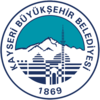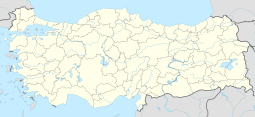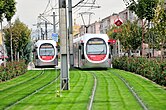Kayseri
Kayseri | |
|---|---|
Clockwise from top:Mount Erciyes,Bürüngüz Mosque in Cumhuriyet Square, Sivas Street,Hunat Hatun Complex,Kayseri Castle,Kayseri Tram,Kadir Has Stadium | |
| Coordinates:38°43′21″N35°29′15″E/ 38.72250°N 35.48750°E | |
| Country | Turkey |
| Region | Central Anatolia |
| Province | Kayseri |
| Government | |
| • Mayor | Memduh Büyükkılıç(AK Party) |
| Area | |
| •Metropolitan municipality | 17,043 km2(6,580 sq mi) |
| • Urban | 3,620 km2(1,400 sq mi) |
| • Metro | 2,810 km2(1,080 sq mi) |
| Elevation | 1,050 m (3,440 ft) |
| Population (31 December 2021 estimate)[1] | |
| •Metropolitan municipality | 1,434,357 |
| • Density | 84/km2(220/sq mi) |
| •Urban | 1,204,641 |
| • Urban density | 330/km2(860/sq mi) |
| •Metro | 1,175,886 |
| • Metro density | 420/km2(1,100/sq mi) |
| GDP | |
| •Metropolitan municipality | TRY107.378 billion US$11.956 billion (2021) |
| • Per capita | TRY75,200 US$8,373 (2021) |
| Time zone | UTC+3(TRT) |
| Postal code | 38x xx |
| Area code | (+90) 352 |
| Licence plate | 38 |
| Website | www |
Kayseri(Turkish pronunciation:[ˈkajseɾi]) is a largecityinCentral Anatolia,Turkey,and the capital ofKayseri province.Historically known asCaesarea,it has been the historical capital ofCappadociasince ancient times. The Kayseri Metropolitan Municipality area is composed of five districts: the two central districts ofKocasinanandMelikgazi,and since 2004, also outlyingHacılar,İncesu,andTalas.
As of 31 December 2021, the province had a population of 1,434,357 of whom 1,175,886 live in the four urban districts, excludingİncesuwhich is not conurbated (i.e. not contiguous, having a largely non-protectedbuffer zone).
Kayseri sits at the foot ofMount Erciyes(Turkish:Erciyes Dağı), a dormant volcano that reaches an altitude of 3,916 metres (12,848 feet), more than 1,500 metres above the city's mean altitude. It contains a number of historic monuments, particularly from theSeljukperiod. Tourists often pass through Kayseri en route to the attractions ofCappadociato the west.
Kayseri is served byErkilet International Airportand is home toErciyes University.
Etymology[edit]
Kayseri was originally calledMazakaorMazaca(Armenian:Մաժաք,romanized:Mažak';according toArmeniantradition, it was founded by and named after Mishak)[3]and was known as such to the geographerStrabo,during whose time it was the capital of the Roman province ofCappadocia,known also asEusebia at the Argaeus(Εὐσέβεια ἡ πρὸς τῷ ἈργαίῳinGreek), afterAriarathes V Eusebes,King ofCappadocia(163–130 BC).
In 14 AD its name was changed byArchelaus(d. 17 AD), the last King of Cappadocia (36 BC–14 AD) and aRomanvassal, to "CaesareainCappadocia"(to distinguish it from other cities with the nameCaesareain the Roman Empire) in honour ofCaesar Augustusupon his death. This name was rendered asΚαισάρεια(Kaisáreia) inKoine Greek,the dialect of the laterByzantine (Eastern Roman) Empire,and it remained in use by the natives (nowadays known asCappadocian Greeks,due to their spoken language, but then referred to asRumdue to their previous Roman citizenship) until theirexpulsionfrom Turkey in 1924. (Note that letterCin classicalLatinwas pronouncedK.When the first Turks arrived in the region in 1080 AD, they adapted this pronunciation, which eventually becameKayseriin Turkish, remaining as such ever since.)[4]
History[edit]


Kayseri experienced three golden ages. The first, dating to 2000 BC, was when the city formed a trade post between theAssyriansand theHittites.The second came under Roman rule (1st to 11th centuries). The third golden age was during the reign of theSeljuks(1178–1243), when the city was the second capital of theSeljuk Sultanate of Rum.The relatively short Seljuk period left a large number of historic landmarks including theHunat Hatun Complex,theKiliç ArslanMosque, the Ulu Camii (Grand Mosque) and theGevher NesibeHastanesi (Hospital).
Ancient history[edit]
AsMazaca(Ancient Greek:Μάζακα),[5]the city served as the residence of the kings ofCappadocia.In ancient times, it was on the crossroads of the trade routes fromSinopeto theEuphratesand from thePersian Royal Roadthat extended fromSardistoSusaduring the 200+ years ofAchaemenid Persianrule. InRomantimes, a similar route fromEphesusto the East also crossed the city.
St Basil,one of the Cappadocian Fathers, established a large monastic complex, the Basileiad, in Caesarea Mazaca in the 4th century. Nothing remains of it today.
The city stood on a low spur on the north side ofMount Erciyes(Mount Argaeusin ancient times). Very few traces of the ancient site now survive.
For more on the Roman and Byzantine eras seeCaesarea (Mazaca).
Islamic era[edit]


TheArabgeneral (and later the firstUmayyadCaliph)MuawiyahinvadedCappadociaand took Caesarea from theByzantinestemporarily in 647.[6]The city was calledKaisariyah(قيصرية) by the Arabs, and laterKayseri(قیصری) by theSeljuk Turks[4]after it was captured byAlp Arslanin 1067. Alp Arslan's forces demolished the city and massacred its population.[7]The shrine ofSaint Basilwas also sacked after the fall of the city.[8]As a result, the city remained uninhabited for the next half century.[7]
From 1074 to 1178 the area was under the control of theDanishmendidswho rebuilt the city in 1134.[9]TheAnatolian Seljuk Sultanatecontrolled the city from 1178 to 1243 and it was one of their most important centres until it fell to theMongolsin 1243. Within the walls lies the greater part of Kayseri, rebuilt between the 13th and 16th centuries. The city then fell to theEretnidsbefore finally becomingOttomanin 1515. It was the centre of a sanjak called initially theRum Eyalet(1515–1521) and then theAngora vilayet(founded as Bozok Eyalet, 1839–1923).
Modern era[edit]

The GrandBazaardates from the latter part of the 1800s, but the adjacentcaravanserai(where merchant traders gathered before forming a caravan) dates from around 1500. The town's older districts (which were filled with ornate mansion-houses mostly dating from the 18th and 19th centuries) were subjected to wholesale demolition starting in the 1970s.[10]
The building that hosted the Kayseri Lyceum was rearranged to host theTurkish Grand National Assemblyduring theTurkish War of Independencewhen theGreek armywas advancing onAnkara,the base of the Turkish National Movement.
Geography[edit]
Climate[edit]
Kayseri has acontinental climate(Köppen:Dsa,Trewartha:Dc). It experiences cold, snowy winters and hot, dry summers with cool nights. Precipitation occurs throughout the year, albeit with a marked decrease in late summer and early fall.
| Climate data for Kayseri (1991–2020, extremes 1931–2021) | |||||||||||||
|---|---|---|---|---|---|---|---|---|---|---|---|---|---|
| Month | Jan | Feb | Mar | Apr | May | Jun | Jul | Aug | Sep | Oct | Nov | Dec | Year |
| Record high °C (°F) | 19.3 (66.7) |
22.6 (72.7) |
28.6 (83.5) |
31.2 (88.2) |
34.2 (93.6) |
37.6 (99.7) |
40.7 (105.3) |
40.6 (105.1) |
38.4 (101.1) |
33.6 (92.5) |
26.0 (78.8) |
21.0 (69.8) |
40.7 (105.3) |
| Mean daily maximum °C (°F) | 4.6 (40.3) |
6.6 (43.9) |
12.2 (54.0) |
17.9 (64.2) |
22.7 (72.9) |
27.4 (81.3) |
31.3 (88.3) |
31.4 (88.5) |
27.1 (80.8) |
20.8 (69.4) |
12.9 (55.2) |
6.5 (43.7) |
18.4 (65.1) |
| Daily mean °C (°F) | −1.0 (30.2) |
0.5 (32.9) |
5.6 (42.1) |
10.7 (51.3) |
15.1 (59.2) |
19.3 (66.7) |
22.7 (72.9) |
22.6 (72.7) |
18.0 (64.4) |
12.4 (54.3) |
5.4 (41.7) |
0.8 (33.4) |
11.0 (51.8) |
| Mean daily minimum °C (°F) | −5.4 (22.3) |
−4.5 (23.9) |
−0.1 (31.8) |
3.9 (39.0) |
7.6 (45.7) |
11.0 (51.8) |
13.5 (56.3) |
13.3 (55.9) |
9.0 (48.2) |
4.9 (40.8) |
−0.5 (31.1) |
−3.6 (25.5) |
4.1 (39.4) |
| Record low °C (°F) | −32.5 (−26.5) |
−31.2 (−24.2) |
−28.1 (−18.6) |
−11.6 (11.1) |
−6.9 (19.6) |
−0.6 (30.9) |
2.9 (37.2) |
1.4 (34.5) |
−3.8 (25.2) |
−12.2 (10.0) |
−20.7 (−5.3) |
−28.4 (−19.1) |
−32.5 (−26.5) |
| Averageprecipitationmm (inches) | 38.0 (1.50) |
38.9 (1.53) |
49.6 (1.95) |
46.9 (1.85) |
57.9 (2.28) |
40.6 (1.60) |
11.9 (0.47) |
9.5 (0.37) |
14.0 (0.55) |
32.3 (1.27) |
29.3 (1.15) |
39.3 (1.55) |
408.2 (16.07) |
| Average precipitation days | 11.4 | 11.0 | 13.1 | 13.6 | 13.5 | 9.7 | 2.3 | 2.2 | 4.5 | 7.1 | 7.8 | 10.2 | 106.4 |
| Averagerelative humidity(%) | 75.9 | 71.5 | 64.3 | 58.9 | 58.9 | 54.5 | 46.6 | 46.7 | 50.5 | 61.6 | 68.1 | 75.3 | 61.0 |
| Mean monthlysunshine hours | 89.9 | 113.0 | 145.7 | 183.0 | 248.0 | 300.0 | 356.5 | 341.0 | 255.0 | 195.3 | 141.0 | 83.7 | 2,452.1 |
| Mean dailysunshine hours | 2.9 | 4.0 | 4.7 | 6.1 | 8.0 | 10.0 | 11.5 | 11.0 | 8.5 | 6.3 | 4.7 | 2.7 | 6.7 |
| Source 1:Turkish State Meteorological Service[11] | |||||||||||||
| Source 2:NOAA(humidity, 1991–2020)[12] | |||||||||||||
Political structure[edit]
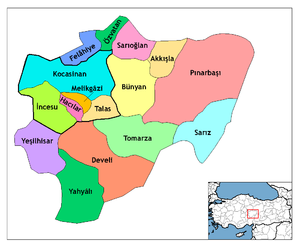
The city of Kayseri consists of sixteen metropolitan districts: Akkışla, Bünyan, Develi, Felâhiye, Hacılar, İncesu, Kocasinan, Melikgâzi, Özvatan, Pınarbaşı, Sarıoğlan, Sarız, Talas, Tomarza, Yahyâlı, and Yeşilhisar.
Demographics[edit]
18,907 Armenians lived in the city of Kayseri in 1914, representing 35% of the total population. Armenians, excluding those who had previously converted to Islam, were either massacred or exiled during theArmenian genocide.The city's Greek Orthodox inhabitants were deported from 1919 to 1921 as part of population exchange between the newly independent Turkish Republic and the Kingdom of Greece.
Local attractions[edit]
In Kayseri[edit]
- Republic Square
- Kayseri Castle
- Kayseri Clock Tower
- Bürüngüz Mosque
- Hunat Mosque
- Kayseri Bazaar (Kapali Carsi)
- Forum Kayseri
- Surp Asdvadzadzin Virgin Mary Church Research Library (Surp Asdvadzadzin Meryem Ana Kilisesi Araştırma Kütüphanesi)
- Atatürk House Museum
- The National Struggle Museum
Inside the centre of Kayseri the most unmissable reminder of the past are the hugebasalt wallsthat once enclosed the old city. Dating back to the sixth century and the reign of the Emperor Justinian, they have been repeatedly repaired, by the Seljuks, by the Ottomans and more recently by the current Turkish government.[13]In 2019Kayseri Archaeology Museummoved from an outlying location to a new site inside the walls.[14]
TheGrand Mosque(Ulu Cami) was started by theDanişmendemirMelik Mehmed Gaziwho is buried beside it although it was only completed by the Seljuks after his death.[13]
There are many magnificent reminders of theSeljuksupremacy in and around the walls as well as many much smallerkümbets(domed tombs) of which the most impressive is theDöner Kümbet(Revolving Tomb). The oldest surviving Seljuk place of worship - and the oldest Seljuk mosque built in Turkey - is theHunat Hatun Mosque complexwhich still includes a functioning hamam with separate sections for men and women dating back to 1238.[13]
Near the mosque is theSahabiye Medresesi,a theological school dating back to 1267 with a magnificent portal typical of Seljuk architecture.[13]Very similar is theAvgunlu (Havuzlu)Medresesiwhich now serves as a large bookshop-cum-cafe in a park.

In Mimar Sinan Park stands theÇifte Medresesi,a pair of Seljuk-era theological schools that eventually served as a hospital for those with psychiatric disorders. They were commissioned by the Seljuk sultanGiyasettin I Keyhüsrevand his sister, Gevher Nesibe Sultan, who is buried inside. Today the buildings house theMuseum of Seljuk Civilisations.[13][15]
Another Seljuk survivor is the grandHalikılıç Mosquecomplex which has two spectacular entrance portals. It dates back to 1249 but was extensively restored three centuries later.[13]
Post-dating the Seljuks is theGüpgüpoğlu Mansionwhich dates back to the early 15th century but is open to the public with the furnishings it would have had in the late 19th century when it was home to the poet and politician Ahmed Midhad Güpgüpoğlu.[13]
Close to the walls is Kayseri's ownKapalı Çarşı(Covered Market), still a bustling commercial centre selling cheap clothes, shoes and much else. Deep inside it is the older and very atmosphericVezir Hanwhich was commissioned in the early 18th century byNevşehir-bornDamad İbrahim Paşawho became a grand vizier toSultan Ahmed IIIbefore being assassinated in 1730.[13]
Around Kayseri[edit]
The Kayseri suburb ofTalaswas the ancestral home ofCalouste Gulbenkian,Aristotle OnassisandElia Kazan.Once ruinous following the expulsion of its Armenian population in 1915 and then of its Greek population in 1923, it was largely reconstructed in the early 21st century. The Greek Orthodox Church of St Mary, built in 1888, has been converted into the Yaman Dede Mosque.[16]Similarly attractive is the suburb ofGermir,home to three 19th-century churches and many fine old stone houses.[17]
Mount Erciyes(Erciyes Dağı) looms over Kayseri and serves as atrekkingandalpinismcentre. During the 2010s an erstwhile small, local ski resort was developed into more of an international attraction with big-name hotels and facilities suitable for all sorts of winter pastimes.[18][19]
The archaeological site of Kanesh-Kültepe,one of the oldest cities inAsia Minor,is 20 km northeast of Kayseri.[20]
Ağırnas,a small town with many lovely old houses, was the birthplace in 1490 of the greatOttomanarchitectMimar Sinan,and a house traditionally associated with him is open to the public as a museum. Beneath it there is one of the 'underground cities' so typical ofCappadocia.The restored church of St Prokopius dates back to 1857 and serves as a cultural centre.[21]
The small town ofDevelialso contains some attractive old houses. The 19th-century Armenian Church of St Mary has been turned into the Aşağı Everek Cami (Lower Everek Mosque).[22]
Economy[edit]
Kayseri received notable public investments in the 1920s and 1930s. Sumer Textiles and Kayseri Tayyare Fabrikasi (an aeroplane manufacturer) were set up here in the post -Republican Erawith the help of German and particularly Russian experts. The latter manufactured the first aircraft "made in Turkey" in the 1940s. After the 1950s, the city suffered from a decrease in the amount of public investment. It was, however, during the same years that Kayseri businessmen and merchants transformed themselves into rural capitalists. Members of families such asSabancı,Has,Dedeman,Hattat,Kurmel,Özyeğin,Karamanlargil andÖzilhanstarted out as small-scale merchants in Kayseri before becoming prominent actors in the Turkish economy. Despite setting up their headquarters in cities such asIstanbulandAdana,they often returned to Kayseri to invest.
Thanks to the economic liberalisation policies introduced in the 1980s, a new wave of merchants and industrialists from Kayseri joined their predecessors. Most of these new industrialists choose Kayseri as a base of their operations. As a consequence of better infrastructure, the city has achieved remarkable industrial growth since 2000, causing it to be described as one of Turkey'sAnatolian Tigers.[23]
The pace of growth of the city was so fast that in 2004 the city applied to theGuinness Book of World Recordsfor the most new manufacturing industries started in a single day: 139 factories. Kayseri also has emerged as one of the most successful furniture-making hub in Turkey earned more than a billion dollars in export revenues in 2007. Its environment is regarded as especially favourable forsmall and medium enterprises.
The Kayseri Free Zoneestablished in 1998 now has more than 43 companies with an investment of 140 million dollars. The Zone's main business activities include production, trading, warehouse management, mounting and demounting, assembly-disassembly, merchandising, maintenance and repair, engineering workshops, office and workplace rental, packing-repacking, banking and insurance, leasing, labelling and exhibition facilities. Kayseri FTZ is one of the cheapest land free zones in the world.[24]
Some social scientists traced this economic success to a modernist Islamic outlook referred to as "Islamic Calvinism" which they said had taken root in Kayseri.[25]
Transport[edit]
The city is served byErkilet International Airport(ASR) which is a short distance from the centre of Kayseri. It offers several flights a day to Istanbul.
Kayseri is connected to the rest of country byrailservices. There are four trains a day toAnkara.To the east there are two train routes, one toKarsand the other toTatvanat the western end ofLake Van.
As the city is located in central Turkey, road transportation is very efficient. It takes approximately three hours to reach Ankara, the same to the Mediterranean coast and 45 minutes toCappadocia.A notableskiresort in winter and accessible for trekking in summer, Mt Erciyes is 30 minutes from the city centre.
Within the city transportation largely relies on buses and private vehicles although there is also alight rail transit (LRT)system calledKayseraywhich runs to the inter-city bus terminal and to Talas.[26]
Sports[edit]

The city had two professionalfootballteams competing in top-flightTurkishfootball.KayserisporandKayseri Erciyessporsimultaneously play in theSüper Lig,making Kayseri one of only two cities having more than one team inSpor Toto Süper Lig 2013–14(the other beingIstanbul). In 2006 Kayserispor became the only Turkish team to have won theUEFA Intertoto Cup.Kayserispor is the remaining professional team in the city, playing in the top flight as of 2023.
TheErciyes Ski ResortonMount Erciyesis one of the largestski resortsin Turkey.
The women's football clubKayseri Gençler Birliğiwas promoted to theWomen's First Leaguefor the2020-21 Leagueseason.[27]
Sports venues[edit]
- Kadir Has Stadiumis a new generation stadium located in the outskirts of the city. Completed in early 2009, theall-seater stadiumhas a capacity of 33,000 spectators and is totally covered. It is shared by the two Kayseri football clubs. The stadium and surrounding sports complex are served by the light-rail system,Kayseray.The stadium was inaugurated with aKayserispor–Fenerbahceleague match. Kadir Has Stadium was one of eight host stadiums for the2013 FIFA U-20 World Cup.It hosted the opening ceremony and the opening match betweenCubaand theRepublic of Korea.
- Kadir Has Sports Arenais an indoor arena opened in 2008. It hasseating capacityfor 7,200 people. Together withKadir Has Stadium,it is a part of the Kayseri Kadir Has Sports Complex, one of Turkey's most modern sports complexes. It was one of the venues for the2010 FIBA World Championship.

Education[edit]

Kayseri High School (Kayseri Lisesi), founded in 1893, is one of Turkey's oldest high schools. Küçükçalık Anatolian High School (Nuh Mehmet Küçükçalık Anadolu Lisesi) was established in 1984 and provides education in English. Kılıçarslan is a private high school which became a sister school withAnatolia CollegeinThessalonikiin 2000.TED Kayseri Collegein theKocasinandistrict is a private, non-profit, co-educationalkindergarten,primary,junior high,andhigh schooland the third largest school in theTEDgroup; since its foundation in 1966 thousands of students have graduated from the school.
Kayseri is home to 3stateand 1privateuniversities.
- Abdullah Gül Universityis the first state university in Turkey to have, as part of its constitution, legal provision for support by a foundation whose efforts are entirely dedicated to the work of the university. It started enrolling students in 2013.
- Erciyes Universityis the city's largest research university. Founded in 1978, it is a successor to schools founded in 1206 and 1956,[28]and currently has 13 faculties, six colleges and seven vocational schools. The university employs more than 3100 academic and administrative personnel and enrols 41,225 students.
- Nuh Naci Yazgan Universityis a private university founded in 2009 with four faculties, two colleges and one vocational school.
Cuisine[edit]
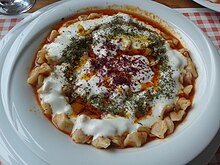
Kayseri has several culinary specialities includingmantı,pastırmaandsucuk.Another speciality is stuffed zucchini flowers made withköfte,garlic and spices. Nevzine is a traditional dessert.
Image gallery[edit]
-
Döner Kümbet
-
Kadir Has Stadium
-
Kadir Has Stadium
-
Kadir Has Stadium
-
Kadir Has Stadium
-
Forum Kayseri
-
City view
-
Kayseri clock Tower
-
Traditional Mansion
-
Erciyes University
-
Hunat Hatun Medresesi dating from 1238
-
Statue of an Assyrian tablet
-
Former Greek church inTalas,now a mosque
-
Erciyes mountain
-
Kayseri Ethnography Museum
Notable people[edit]
- Nuri Demirağ(1883-1957),aircraft maintenance engineer,businessmanandpoliticianoffounderinMillî Kalkınma Partisi
- Naci Demirağ(1890-1944),engineerandbusinessman
- Hasan Kaçan(1957-), theEkmek TeknesiTurkishTV seriesof in "HerodotCevdet"character actor,caricaturist,screenwriteranddrawingofGırgır,Cumhuriyet,Hıbır,Ustura,Yeni Şafak
- Metin Kaçan(1961-2013),TurkishmalewriterofAğır RomanandbrotherHasan Kaçan
- Hulusi Akar(1952-),soldierandpoliticianin theformerofGeneral Staff of the Turkish Armed Forcespresident,the oldpresentofMinistry of National Defense (Turkey)ministerand in the28thAK PartyKayserimember of parliament
- Şule Yüksel Şenler(1938-2019), theIslamistwomenwriter,poet,senaristandislamic democracyactivist
- Hacı Ömer Sabancı(1906-1966),businesspersonandfounderofSabancı Holding
- Hasan Nasil Canat(1943-2004),actor
- Hacı Boydak(1953-),businessmanandfounderofBoydak Holding
- Berna Gözbaşı(1974-), thepresidentofKayserispor
- Sakıp Sabancı(1933-2004),businessmanand thebillionairein oldCEO'sSabancı Holding
- Güler Sabancı(1955-),businesswomanandCEO's ofSabancı Holding
- İzzet Özilhan(1920-2014),businessmanandfounderofAnadolu Grubu
- Kadir Has(1931-2007),businessman
- Alparslan Türkeş(1917-1997),soldierandpoliticianinfounderofNationalist Movement PartyinideologyIdealism
- Mehmet Topuz,footballer
- Tuncay Özilhan(1947-),businessmanand theCEOofAnadolu Group
- Asım Kibar(1933-),businessmanandfounderofHyundai Assan Otomotiv
- Tuğrul Türkeş(1954-),economist,academicianandpoliticianinfounderofBright Turkey Party
- Hüsamettin Özkan(1950-),politician,formerDeputy Prime Minister of Turkey
- Hayrünnisa Gül(1965-),11thFirst LadyandAbdullah Gül'swife
- Abdullah Gül(1950–),11thPresident of Turkey
Kayseri metropolitan municipality mayors[edit]
- 1984-1989Hüsamettin ÇetinbulutANAP
- 1989-1994Niyazi BahçecioğluSHP
- 1994-1998Şükrü KaratepeRefah Party,Virtue Party
- 1998-2015Mehmet ÖzhasekiVirtue Party,AK Party
- 2015-presentMehmduh BüyükkkılıçAK Party
Twin towns – sister cities[edit]
See also[edit]
References[edit]
- ^"Turkey: Administrative Division (Provinces and Districts) - Population Statistics, Charts and Map".Citypopulation.de.
- ^"Statistics by Theme > National Accounts > Regional Accounts".turkstat.gov.tr.Retrieved11 May2023.
- ^Olmstead, A. T. (1929)."Two Stone Idols from Asia Minor at the University of Illinois".Syria.10(4): 311–313.doi:10.3406/syria.1929.3413.JSTOR4236961.Retrieved30 June2022– via JSTOR.
- ^abEverett-Heath, John (2005).Kayseri.Oxford University Press.Retrieved2007-12-11.
{{cite book}}:|work=ignored (help) - ^"Strabo, Geography, Book 12, chapter 2, section 7".Perseus.tufts.edu.Retrieved30 June2022.
- ^Ostrogorsky, George. History of the Byzantine State. New Jersey: Rutgers University Press, 1969. Pg 116.
- ^abAsh, John (2006).A Byzantine journey([2. ed.] ed.). London: Tauris Parke Paperbacks. p. 167.ISBN9781845113070.
In that year theTurkscaptured Caesarea, the chief city of eastern Cappadocia, burnt it to the ground, massacred its inhabitants and descrated the great shrine of Saint Basil.
- ^Vaughan, Louis Bréhier; translated by Margaret (1977).The life and death of Byzantium.Amsterdam: North-Holland Pub. Co. p. 193.ISBN9780720490084.
In the spring of 1067 he invaded the Pontus and penetrated as far as Caesarea in Cappadocia which he demolished
{{cite book}}:CS1 maint: multiple names: authors list (link) - ^Speros Vryonis,Vryonis Decline of Medieval Hellinism in Asia Minor | PDF | Anatolia | Byzantine EmpireThe Decline of Medieval Hellenism in Asia Minor and the Process of Islamization from the Eleventh through the Fifteenth Century]Archived2017-02-02 at theWayback Machine(University of CaliforniaPress, 1971), p. 155
- ^"Armenian Architecture – VirtualANI – The Traditional Houses of Kayseri".Virtualani.org.Archivedfrom the original on 2007-05-23.
- ^"Resmi İstatistikler: İllerimize Ait Mevism Normalleri (1991–2020)"(in Turkish). Turkish State Meteorological Service.Retrieved6 July2021.
- ^"World Meteorological Organization Climate Normals for 1991–2020".World Meteorological Organization. Archived fromthe originalon 17 July 2021.Retrieved2 August2023.
- ^abcdefgh"KAYSERİ".turkeyfromtheinside.Retrieved2022-12-22.
- ^"Kayseri Archaeology Museum"(PDF).
- ^"Museum of Seljuk Civilisation | Kayseri, Turkey | Attractions - Lonely Planet".lonelyplanet.Retrieved2022-12-22.
- ^"TALAS".turkeyfromtheinside.Retrieved2022-12-22.
- ^"GERMİR".turkeyfromtheinside.Retrieved2022-12-22.
- ^"Erciyes Ski Resort".kayserierciyes.tr.Retrieved2022-12-22.
- ^"ERCİYES DAĞI (MT ERCIYES)".turkeyfromtheinside.Retrieved2022-12-22.
- ^"KÜLTEPE".turkeyfromtheinside.Retrieved2022-12-22.
- ^"AĞIRNAS".turkeyfromtheinside.Retrieved2022-12-22.
- ^"DEVELİ".turkeyfromtheinside.Retrieved2022-12-22.
- ^ESI."Islamic Calvinists: Change and Conservatism in Central Anatolia"(PDF).European Stability Initiative,Berlin.Archived(PDF)from the original on 2005-12-10.Retrieved2005-09-19.
- ^"KAYSER -Kayseri Serbest Bölgesi".Archived fromthe originalon 2013-12-05.
- ^"Chronology of all ESI publications – Reports – ESI".Esiweb.org. 2005-09-19.Archivedfrom the original on 2012-06-03.Retrieved2012-08-13.
- ^"Kayseri Ulaşım A.Ş."Kayseri Ulaşım A.Ş.(in Turkish).Retrieved2022-12-21.
- ^"2019-2020 Sezonu Kadın Ligleri Yönetim Kurulu Kararı - 2- Kadınlar 2. Ligi"(in Turkish). Türkiye Futbol Federasyonu. 13 July 2020.Retrieved10 October2020.
- ^"Tarihçe".Archived fromthe originalon 2021-07-28.Retrieved2021-07-28.
- ^"Kayseri'nin Kardeş Şehirleri".kayseriyerelhaber(in Turkish). Kayseri Yerel Haber. 2014-11-07.Retrieved2022-10-31.
- ^"Humus Kayseri".2015-04-02. Archived fromthe originalon 2016-12-27.
- ^"Шуша и Кайсери станут городами–побратимами".interfax.az(in Russian). Interfax Azerbaijan. 2021-04-13.Retrieved2021-07-29.








